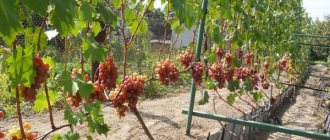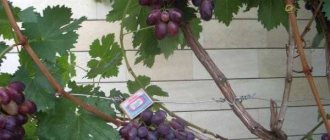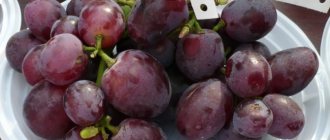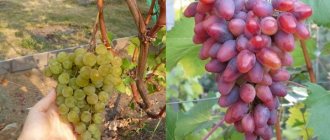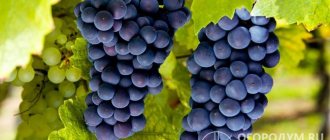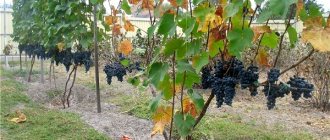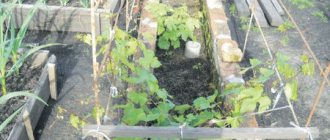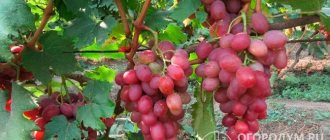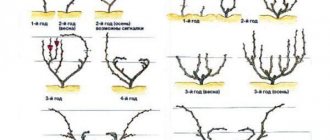Advantages and disadvantages
Like any other grape variety, Sofia has certain characteristics, a number of advantages and disadvantages.
The main positive characteristics of the variety include:
- Early maturation.
- Pleasant taste.
- Frost and drought resistance.
- Good survival rate.
- Immunity to many diseases.
Also, bunches of Sofia grapes have a good presentation, tolerate transportation well, and the berries can be used for making juice or consumed fresh.
Among the disadvantages of “Sofia” are noted:
- The presence of only female flowers.
- Tendency to gray rot.
- Fruit rotting due to high cluster density.
It should also be taken into account that the harvest must be harvested in a timely manner, otherwise the berries will crumble and crack.
The secret of large berries
As gardeners note in reviews, the Sofia variety is not an unpretentious plant. It needs special care, then the berries will be large, and the clusters will not pea. Let us reveal a few secrets to future winegrowers:
- During flowering, it is necessary to artificially pollinate the grapes. To do this, use a powder puff. Thanks to this procedure, the density of the bunch increases.
- You should leave no more than 30 brushes on the bush. More clusters result in smaller berries.
- It is necessary to monitor the number of primordia formed. If there are a lot of them, you need to thin them out. There is no need to spare the ovary, otherwise, due to too much density, some of the berries will begin to rot.
- If some berries in the bunch are lagging behind in development, then during filling they need to be removed so that they do not draw nutrients onto themselves.
- The plant needs to be sprayed against gray rot so that the appearance of the bunch and taste do not deteriorate.
- Large and tasty berries grow with regular feeding.
The celebrity among cherry tomatoes is the Yellow Cherry tomato: description of the variety and features of its cultivation
Origin
The Sofia grape variety was developed in the late 90s. XX century as a result of selection work of the Ukrainian amateur winegrower V.V. Zagorulko. The varieties “Arcadia” and “Kishmish radiant” were chosen as parent plants, from which “Sofia” adopted the best characteristics: short ripening period, stable yield, large fruit and excellent taste.
“Sofia’s” parents are “Arcadia” and “Kishmish Radiant”
Reference! In addition to “Sofia”, V.V. Zagorulko created the varieties “Asya”, “Vodograi” and “Viking”.
Reproduction
The Sofia grape is a unique plant because it can be propagated in various ways:
- seeds;
- layering;
- cuttings;
- seedlings;
- through vaccination.
For grafting, a rootstock on which the wood has matured is used. The effect of this method is the presence of an excellent root system. Fruiting begins a whole year earlier.
Important! Tall grape varieties are used as a rootstock so that the plant does not lose this quality in the future.
When propagating by layering, choose the most productive bush with powerful and strong shoots. It is laid horizontally on the surface and sprinkled with fertile soil. To prevent the layer from rising, it is pinned. During rooting, it is necessary to monitor the condition of the soil: drying out is not allowed. When good roots appear on the layering, you can transplant it to a permanent place.
The seed method of growing Sofia grapes takes longer, but the result is always positive.
Main characteristics
“Sofia” is a table grape variety whose fruits have a pleasant taste and are characterized by the possibility of universal use.
Maturation period and class
“Sofia” is an early ripening grape variety, the growing season of which lasts 100-115 days. The harvest can be harvested already in the first half of August.
Bush
The bushes are vigorous, characterized by a developed, active root system and a powerful bright brown vine, which begins to darken in the fall.
The leaf blades are large, round in shape, not pubescent, with slight dissection, slight waviness at the edges is possible. Young foliage is dark green, turning yellow-green in autumn.
Harvest of a young bush “Sofia”
The flowering period, when small white flowers appear on the bushes, collected in racemes, is long. Only female flowers are formed on the bushes, so this variety requires pollinating plants to form fruits. It is best to plant Arcadia nearby - this will help eliminate the possibility of cross-pollination and loss of varietal qualities.
Reference! Despite the difficulty in propagation, the “Sofia” variety produces abundant harvests and is not prone to peas.
Bunches and berries
The brushes are large, have a conical shape and weigh on average from 800 g to 1.2 kg, but sometimes there are specimens whose weight is 3 kg. The berries are located close to each other, so they should be thinned regularly to avoid rotting.
The fruits are slightly elongated, ovoid in shape, reach 2.8-3.6 cm in length, 2.0-2.1 cm in width and weigh about 15 g. The berries are covered with a thin but dense skin of pale pink veins.
The flesh is fleshy, juicy and tender; there can be a maximum of 2 small and soft bones inside, but often there are none at all. Sugar content is about 20%.
Taste
The fruits are sweet and have a bright nutmeg aftertaste.
Productivity
Fruiting begins 2 years after planting - up to 10 kg of grapes can be harvested from one bush of this age. Later, mature and mature bushes produce about 50-70 kg of fruit, the yield from 1 hectare of land is 10-15 tons.
Grapes Sofia: description of the variety
Sofia is distinguished by its rather high vigor. The leaves are very large, slightly dissected, often wavy, rich green (yellowness increases in autumn).
The upper young leaves and the crown of the shoots are rich green, not pubescent. The flowers are functionally female, but if there are hermaphroditic varieties nearby, they do not experience problems with pollination (the best pollinator for Sofia is the Arcadia variety).
Korolek, Ruta, and Jubilee of the Kherson Summer Resident also have female flowers.
The bunch is large (about a kilogram in weight, can even reach two, and sometimes three), cone-shaped, moderately dense, rarely pea-shaped. The berries are large (up to 15-16 g), light red, egg-shaped, with 2-3 seeds inside. The skin is moderately thick. you don't feel it when eating. The pulp is juicy and fleshy. The vine is bright brown, powerful.
Comparison with analogues
Next, let’s compare “Sofia” with the main competitors in your area.
| Sign | Variety | |||
| Sofia | Transfiguration | Laura | Pink haze | |
| Ripening period | ||||
| Frost resistance | Up to -21 °C | Up to -18 °C | Up to -23-26 °C | Up to -23 °C |
| Yield per bush | ||||
| Bunches | From 800 g to 1.2 kg | From 800 g to 1 kg | Up to 1 kg | 700-800 g |
| Taste | Muscat aftertaste | Harmonious with slight sourness | Light aroma of nutmeg | Harmonious |
| Color | Light pink | Amber pink | Light green, amber on the sunny side | White with pink blush |
| Disease resistance | Average | Low | High | High |
| Shelf life | 3-5 weeks | Up to 6 months | A few months | A few months |
| Sugar content | 20% | 17-19% | 20% | 16,8-18,5% |
| Acidity | There is no information about acidity, but the taste is assessed as low | 7 g/l | 8 g/l | 7 g/l |
What gardeners are talking about
Reviews
Vladimir
Vyacheslav
| i.ytimg.com ” src=”https://qlumba.com/wp-content/uploads/2019/11/fmg5dbeb2854ef125.jpg” alt=”table_pic_” w /> | Step 1. Watering |
- water the plants at the roots so that water does not get into the foliage;
- young bushes are actively growing, so they need more moisture;
- abundant watering at the beginning of fruiting;
- during the flowering period, stop watering;
- in October, water thoroughly for the winter
hobby-house.com ” src=”https://qlumba.com/wp-content/uploads/2019/11/fmg5dbeb288551394.jpg” alt=”table_pic_” w />
Step 2: Create a support
- construct a trellis, arch or pergola for grape bushes
- attach the main sleeves to the support;
- tie the shoots coming from them 2-3 to each wire;
- it is better to use a horizontal garter
dcactus.ru ” src=”https://qlumba.com/wp-content/uploads/2019/11/fmg5dbeb289775894.jpg” alt=”table_pic_” w />
Step 3. Feeding
- if all appropriate fertilizers are applied during planting, then the grapes are not fertilized for 3-4 years;
- subsequently feed three times per season;
- in early spring, add dry fertilizers - superphosphate, potassium, nitrogen;
- during the flowering period, fertilize with mullein infusion and mineral compounds;
- during the ripening period, feed with phosphorus and potassium 2:1
svoimi-rykami.ru ” src=”https://qlumba.com/wp-content/uploads/2019/11/fmg5dbeb289a26de8.jpg” alt=”table_pic_” w />
Step 4: Trimming
- pruning is carried out annually;
- in spring - sanitary pruning - remove dried and damaged shoots;;
- we form bushes, leaving several main branches;
- depending on the variety, leave from 8 to 12 eyes on the shoots;
- pinch branches in summer to increase yield and form a bush
hozvo.ru ” src=”https://qlumba.com/wp-content/uploads/2019/11/fmg5dbeb28a27dd05.jpg” alt=”table_pic_” w />
Step 5. Prepare for winter
- for the first few years, cover young bushes with the onset of cold weather;
- shoots are removed from the support and bent to the ground;
- pre-form a substrate from boards or spruce branches;
- the shoots are wrapped in dry non-woven material;
- sprinkle dry leaves or soil on top;
- leave windows for oxygen access and cover with polyethylene to protect from getting wet
moyvinograd.ru ” src=”https://qlumba.com/wp-content/uploads/2019/11/fmg5dbeb28aa36ea8.jpg” alt=”table_pic_” w />
Step 6. Prevention of diseases and pests
- promptly remove and burn infected plant debris and diseased bushes;
- carry out preventive spraying with fungicidal preparations - Bordeaux mixture, colloidal sulfur, copper chloride;
- irrigate a week before flowering, during flowering and after it, when the first berries appear
Caring for grapes - in this video:
Use and beneficial properties
Grapes are a storehouse of useful macro- and microelements. Thus, the berries contain ascorbic acid, vitamin A, PP, K, B, etc., as well as natural sugars, pectins, iron, calcium, chromium, phosphorus, zinc, potassium, cobalt, silicon, boron and amino acids.
Since “Sofia” is a table variety, its fruits can be consumed fresh. The berries are also suitable for making raisins, juices, jams, compotes and desserts. Often the fruits of this grape (solo or in combination with other varieties) are used to make wine.
Features of cultivation
The standards for growing Sofia grapes are practically no different from those required for most other varieties. However, there are a number of specific features that must be observed in order for the bushes to grow and develop well, and for the harvest to be plentiful. So, in addition to providing competent care, grapes must be planted correctly, taking into account their needs in relation to the place.
Landing
Sofia grapes can be planted on a plot in the spring, when the soil has warmed up sufficiently (mid-late March) , or in the fall (early October). It is better to give preference to spring planting, since in this case the plant will have time to take root, adapt to new conditions and prepare for winter.
The place for planting grapes should be located on a hill and be spacious and well lit. It is best to choose the southern, most illuminated part of the garden, away from buildings and tall vegetation, where groundwater lies no higher than 1.5-2 m, otherwise it is necessary to equip a drainage system.
The “Sofia” variety does not make any special demands on the soil, but prefers fertile loams. If the soil is not very fertile, it must be prepared before planting grapes. To do this, humus and sand need to be added to the soil, which contains a lot of clay, and sandstones, on the contrary, should be covered with clay and organic fertilizers. You can reduce the acidity of the soil using slaked lime.
Watering and fertilizing
Proper watering is one of the main requirements of the variety. "Sofia" does not tolerate overly moist soil and prolonged drought, so the bushes must be watered regularly, but in moderation.
Under favorable weather conditions, the plant should be watered 5 times during the season:
- When the buds open.
- At the beginning of flowering.
- With the growth of ovaries.
- After the harvest.
- At the end of autumn.
Reference! Under each bush you need to pour up to 60 liters of water in the case of regular watering and up to 120 liters when watering in the fall.
Fertilizer application must be combined with watering. “Sofia” reacts negatively to excess nitrogen-containing fertilizers, so preference should be given to potassium-phosphorus compositions.
Also, 2-3 times a year it is necessary to use organic fertilizers (humus or diluted manure), laying them in the form of mulch at a distance of 5-7 cm from the trunk.
Trimming
Pruning is an essential component in caring for vigorous Sofia bushes , helping to facilitate not only caring for the plant, but also harvesting.
This procedure is carried out in spring and autumn and consists of removing old, diseased or damaged vines and shortening young shoots by at least 4-6 buds. The optimal bush shape for this variety is fan-shaped, with 3-4 main shoots and many lateral shoots.
You should also standardize the bunches - this can significantly improve the quality and abundance of the harvest and avoid damage to young shoots by eliminating excessive load on the bush. One fruiting shoot should have no more than 3, and ideally 1-2, clusters.
Diseases and pests
The variety has a fairly high degree of resistance to diseases characteristic of grapes, for example, mildew, oidium.
At the same time, you should not rely on the immunity of the bushes and neglect preventive spraying, especially if other grape varieties are planted on the site. For processing, Bordeaux mixture, karbofos, vitriol and other special preparations should be used.
Among the pests, the greatest danger to Sophia is wasps and birds.
Frost resistance
The variety is able to tolerate frosts down to -21 °C and, provided it is grown in the southern regions, does not require shelter. It should be taken into account that if the thermometer drops below, uncovered grapes may die.
If we are talking about cultivating “Sofia” in the central or northern zone, the bushes must be covered for the winter by removing the vine from the supports after autumn pruning, pressing it to the ground and covering it with thick fabric, wooden shields, earth or snow.
Harvest storage
To avoid shedding, cracking or rotting of the berries, the crop should be harvested immediately after it ripens.
On average, the harvest is stored for 3 weeks , but if the grapes are stored in a refrigerator or cellar at a temperature of 0 to +5 ° C, the shelf life can be extended to 4-5 weeks.
Growing regions
The variety can be successfully grown in the southern regions. It is also possible to cultivate “Sofia” in the central regions, where there are no too harsh winters, but in the middle zone this grape cannot be grown due to insufficient sun and heat.
When is the best time to plant this grape variety?
It should be noted that planting grape crops can be done from spring to late autumn. Planting time directly depends on which planting method you choose.
In the spring, seedlings are planted. They can be grown from cuttings or simply left over from the fall. The first planting can be done as early as March, when relatively warm air temperatures have established. And in order for the seedling not to freeze, it should be covered. This can be done using a regular cardboard box with a small hole for the top. It will be possible to remove it in early May
If we talk about seedlings that were grown from cuttings, then they should be planted in the first half of June
It is very important that the seedling grows well in the glass, so that later it will be convenient to replant it along with the soil from the glass
Spring planting has its advantages:
- A bush that was planted in the spring manages to adapt well and take root. A well-developed root system is capable of independently feeding the bush.
- Seedlings that were planted in the spring begin to bear fruit much faster.
Photo
Below, check out the photos and reviews about the “Sofia” variety.
Reviews
Sofia gave me her first harvest last year. It tastes great with a light nutmeg. The berry is 1.5 times larger in size than Arcadia, clusters up to 1 kg. The presentation is awesome. Vladimir, Poltava region.
The variety is worthy of the best praise for table varieties. Although the bushes were a little overloaded, the vines were 10 -12 mm. matured by autumn along the entire length of the coinage. The bunches were removed as they ripened and were in good demand on the market. When fully ripe, they acquired a soft pink color. The weight of the bunches reached 2.5 kg. Ivan, Dnepr
The taste is amazing! Petr Ivanchenko, Kharkov
No matter what they say, Sofia amazed me! First fruiting (grafted on Augustine), ready!!! The bunch is small, but very dense, the berries are very large, the taste is very pleasant. Yuri Nikolaevich, Volgograd region, Kamyshin
